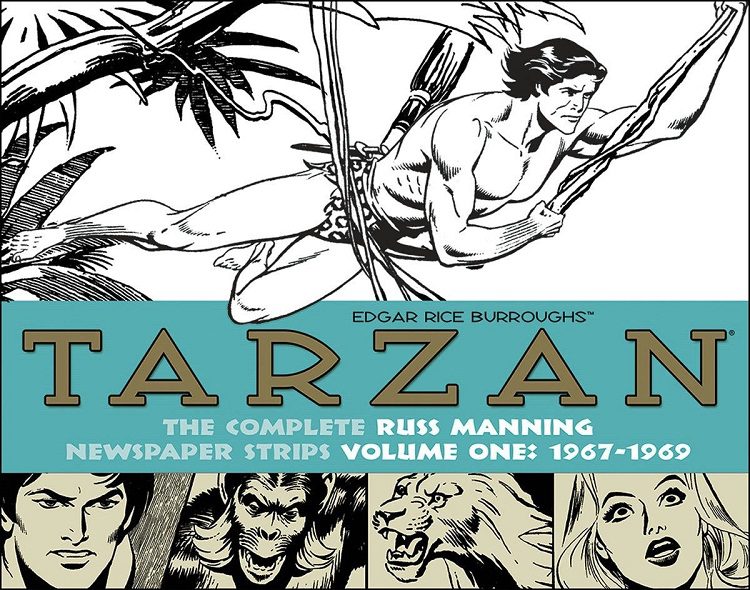
As stated on the last page of this book, “The Library of American Comics [published by IDW] is dedicated to preserving, in definitive editions, the long and jubilantly creative history of the American newspaper comic strip.” They shine a well-deserved spotlight on the very talented Russ Manning in the first of four volumes collecting his Tarzan newspaper strips.
As William Stout, artist and former assistant to Manning, reveals in the book’s foreword, Manning began his comics career at Western Publishing in 1952 and began a long professional association with Edgar Rice Burroughs’ famous creation. He did occasional art on their Gold Key Tarzan comic book before becoming its main “artist for a four-year stint beginning in 1965 and also drew the first eleven issues of the Korak, Son of Tarzan series.” He “became the writer and artist for the Tarzan of the Apes Sunday and daily newspaper strips in 1967. He ended the dailies in 1972, but he continued the Sunday strips into 1979 in addition to creating four Tarzan graphic novels.”
The two dailies stories featured are “Tarzan, Jad-Ben-Otho,” which ran about 10 months from December 11, 1967 to October 5, 1968, and “Tarzan and the Renegade,” which ran for just over 53 weeks until October 18, 1969. The three Sunday stories are “Tarzan Returns to the Land of the Ant Men,” “Tarzan and the Return of Dagga Ramba,” and “Korak and the Elephant Girls” that collectively ran from January 14, 1968 to May 11, 1969.
Manning uses the original version of the character he grew up reading and enjoying in ERB’s books. Tarzan is not the monosyllabic “me Tarzan, you Jane” character unfortunately memorialized in the movies. He’s John Clayton, son of the late Lord and Lady Greystoke. He is a man as intelligent as he is athletic. He lives on an estate with his wife Jane and together they have a son, who goes by the name Korak. Manning signals the return of the character to its roots in the first panel of the first strip where Tarzan thinks, “it is time I returned to the best land of all – home” has two meanings. Manning’s strips also used ideas from ERB’s work. Examples include: the city of Opar from The Return of Tarzan, the Land of Pal-ul-don in Tarzan the Terrible, the diminutive Ant Men from the coincidentally titled Tarzan and the Ant Men, and the character Mugambi from The Beasts of Tarzan.
Stout gives glowing tributes to Manning as a writer, as an artist, and as a man. I don’t know about the latter, but the evidence of the first two are clearly on display. Although he had assistants, Manning was the main creative force behind the panels. He wrote the scripts, drew the art in both pencil and ink, lettered the dialogue and exposition, and colored the Sundays strips. Every element is of outstanding quality and are a treasure to behold.
Although the strips are over 40 years old, they don’t show any ill effects from their age. The adventures are compelling and believable in the world they are set. While Tarzan is the main hero of these stories, the other characters are interesting as well. I never found myself in a hurry to get back to Tarzan when someone else was the focus for part of the story. A very impressive aspect is how well the pacing works. Almost each daily ends with a bit of a cliffhanger to get the reader to come back the next day, yet there’s no detriment to the flow of the story when reading weeks or even months at a time.
The action is constant as the characters continually find themselves battling villains and having to rescue one another or be rescued. Jane frequently finds herself in the latter position, although she doesn’t hesitate heading into danger to find her husband and/or son. I just wish she had been a little less of a damsel-in-distress, which is my only minor criticism of the stories.
Manning keeps the reader off balance about what is really going on with the way he presents information. The first daily strip ends with a lion sitting in wait. This must have created enormous suspense for a reader who had to wait a day before the next strip showed a distracted Tarzan getting pounced upon by the lion. Then it would be another day before expectations were up-ended when the lion is revealed to be Tarzan’s friend, Jad-bal-jada.
Manning’s visual storytelling might even be more remarkable. His drawings offer brilliance in the fine line work and detail, the use of shading and black, and the framing of images. Though single panels, he creates a sense of movement and action, like watching animation. It’s hard to imagine the art looking any better and then the Sunday strips section does just that when Manning adds color to his arsenal.
For fans of comics and adventure, I can’t recommend Tarzan: The Complete Russ Manning Newspaper Strips, Volume One highly enough. Volume Two is set to be released in November and it can’t come soon enough.